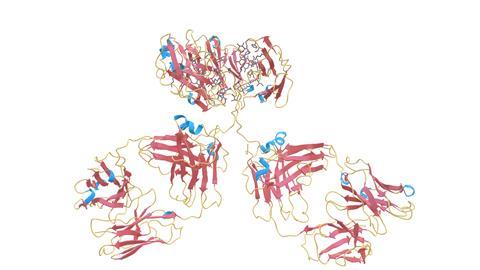It appears that a small group of antibodies dominates and personalises the entire repertoire of the immune system. Researchers at Utrecht University discovered that these antibodies remain virtually unchanged in composition and quantity, even after vaccinations. They published their findings in Science Advances.
Antibodies play an essential role in our immune system and in providing long-term immunity against diseases. They help the body clear viruses and bacteria by binding to specific antigens on their surfaces. To optimise this binding process, the immune system can refine the structure of the antibodies over time.
Now, researchers from Utrecht University and their international colleagues have discovered that the majority of antibodies change very little. They demonstrated this by analysing blood samples taken from eleven healthy volunteers over the course of a year. During that year, the volunteers received three doses of the Pfizer-BioNTech vaccine. Danique van Rijswijck, the first author and a molecular biologist at Utrecht University, said: ‘Over the course of a year, we saw the same antibodies with the same concentration dominate the antibody repertoire despite the vaccinations. This was completely contrary to our expectations.’
Unchanged clones
When your body first comes into contact with a virus, it activates special immune cells (B cells). During the initial phase of the immune response, some of these B cells mature into short-lived plasma cells — specialised immune cells that produce antibodies against the virus. Each plasma cell produces one specific type of antibody with a unique structure – a clone. As some of the B cells continue to develop into new plasma cells, new clones are constantly created. The structure of these new clones builds on that of previous clones, enabling them to perform their function (e.g. recognising the SARS-CoV-2 virus) even better.
However, as these plasma cells have a short lifespan, their antibodies disappear from the blood after just a few weeks. This changes in the case of a prolonged immune response, when some of the B cells transform into long-lived plasma cells that migrate to the bone marrow. ‘If you become reinfected after twenty years, you will probably produce slightly different antibodies’, says Van Rijswijck. ‘That is, unless long-lived plasma cells have already reached the bone marrow. In that case, they continuously produce identical copies of these antibodies to fight the infection.’
The researchers originally intended to use their study to measure the immune response to vaccinations, but the outcome was quite different. ‘We couldn’t measure a clear response because other antibodies were so dominant that they drowned out the signal from the antibodies against the vaccination’, explains Van Rijswijck. ‘That’s why we were initially disappointed with the results. But then we discovered that no one had ever measured such an unchanging abundance of dominant antibodies. As they remained at the same level for such a long time, they must have been produced by long-lived plasma cells in the bone marrow.’
Weighing molecules
The researchers used mass spectrometry to determine which antibodies were present in the blood. Albert Bondt, the molecular biologist who helped coordinate the research, explains: ‘Antibodies consist of several hundred building blocks. If one of these changes, the weight also changes. Although antibodies are very similar, we can distinguish between all the clones thanks to minimal differences in mass.’
According to Bondt, the fact that researchers had not previously realised that a small group of permanent antibodies dominate the immune profile is largely due to technological limitations. ‘Mass spectrometry allows us to study antibodies individually and examine them in great detail’, he explains. ‘Clinical studies often investigate whether an immune response exists, rather than what it looks like exactly. They look at the overall number of antibodies or use filtering techniques to search for the production of a specific antibody. However, thanks to the accuracy of the technique, we were able to distinguish between all the individual clones and observe that the majority remained unchanged.’
Lifelong protection
The next step for the researchers is to find out why these clones are so prevalent in the blood. ‘We don’t yet understand why this small group of different antibodies is produced in such large quantities’, says Van Rijswijck. ‘That’s why we hope to discover their purpose.’
This study could also help researchers gain more insight into how long-term immunity works. In some diseases, such as COVID, the immune response is short-lived and the protection disappears quickly. By measuring the response to different vaccines, the researchers hope to determine whether and when a transition to long-term immunity occurs. ‘In an optimally functioning immune system, plasma cells move to the bone marrow to produce the necessary antibodies for life’, says Bondt. ‘We want to understand when and why they do that.’
Van Rijswijck, D.M.H. et al. (2025) Sci. Adv. 11(16), DOI: 10.1126/sciadv.adt7746













Nog geen opmerkingen